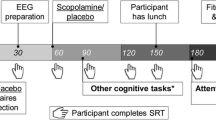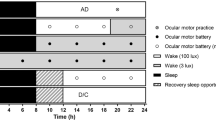Abstract
Rationale
It has been shown that antagonism of the glutamatergic N-methyl-D-aspartate (NMDA) receptor with subanesthetic doses of ketamine perturbs the perception of elapsed time. Anticipatory eye movements are based on an internal representation of elapsed time. Therefore, the occurrence of anticipatory saccades could be a particularly sensitive indicator of abnormal time perception due to NMDA receptors blockade.
Objectives
The objective of this study was to determine whether the occurrence of anticipatory saccades could be selectively altered by a subanesthetic dose of ketamine.
Methods
Three Rhesus monkeys were trained in a simple visually guided saccadic task with a variable delay. Monkeys were rewarded for making a visually guided saccade at the end of the delay. Premature anticipatory saccades to the future position of the eccentric target initiated before the end of the delay were not rewarded. A subanesthetic dose of ketamine (0.25 mg/kg) or a saline solution of the same volume was injected i.m. during the task.
Results
We found that the injected dose of ketamine did not induce sedation or abnormal behavior. However, in ∼4 min, ketamine induced a strong reduction of the occurrence of anticipatory saccades but did not reduce the occurrence of visually guided saccades.
Conclusion
This unexpected reduction of anticipatory saccade occurrence could be interpreted as resulting from an altered use of the perception of elapsed time during the delay period induced by NMDA receptors antagonism.






Similar content being viewed by others
References
Abi-Saab WM, D'Souza DC, Moghaddam B, Krystal JH (1998) The NMDA antagonist model for schizophrenia: promise and pitfalls. Pharmacopsychiatry 31:104–109
Ameqrane I, Pouget P, Wattiez N, Carpenter R, Missal M (2014) Implicit and explicit timing in oculomotor control. PLoS One 9(4):e93958
Arnsten AF (2013) The neurobiology of thought: the groundbreaking discoveries of Patricia goldman-rakic 1937–2003. Cereb Cortex 23:2269–2281
Avila MT, Weiler MA, Lahti AC, Tamminga CA, Thaker GK (2002) Effects of ketamine on leading saccades during smooth-pursuit eye movements may implicate cerebellar dysfunction in schizophrenia. Am J Psychiatry 159:1490–1496
Badler JB, Heinen SJ (2006) Anticipatory movement timing using prediction and external cues. J Neurosci 26:4519–4525
Breier A, Malhotra AK, Pinals DA, Weisenfeld NI, Pickar D (1997) Association of ketamine-induced psychosis with focal activation of the prefrontal cortex in healthy volunteers. Am J Psychiatry 154(6):805–811
Buhusi CV, Meck WH (2005) What makes us tick? Functional and neural mechanisms of interval timing. Nat Rev Neurosci 6:755–765, Review
Carlsson A, Hansson LO, Waters N, Carlsson ML (1999) A glutamatergic deficiency model of schizophrenia. Br J Psychiatry Suppl 37:2–6
Carroll CA, Boggs J, O’Donnell BF, Shekhar A, Hetrick WP (2008) Temporal processing dysfunction in schizophrenia. Brain Cogn 67:150e161
Carroll CA, O’Donnell BF, Shekhar A, Hetrick WP (2009a) Timing dysfunctions in schizophrenia span from millisecond to several-second durations. Brain Cogn 70:181e190
Carroll CA, O’Donnell BF, Shekhar A, Hetrick WP (2009b) Timing dysfunctions in schizophrenia as measured by a repetitive finger tapping task. Brain Cogn 71:345e353
Condy C, Wattiez N, Rivaud-Pechoux S (2005) Gaymard B (2005) ketamine-induced distractibility: an oculomotor study in monkeys. Biol Psychiatry 57:366–372
Corlett PR, Honey GD, Fletcher PC (2007) From prediction error to psychosis: ketamine as a pharmacological model of delusions. J Psychopharmacol 21(3):238–252, Review
Coull JT (2014) Getting the timing right: experimental protocols for investigating time with functional neuroimaging and psychopharmacology. Adv Exp Med Biol 829:237–264
Coull JT, Morgan H, Cambridge VC, Moore JW, Giorlando F, Adapa R, Corlett PR, Fletcher PC (2011) Ketamine perturbs perception of the flow of time in healthy volunteers. Psychopharmacology (Berl) 218(3):543–556
Davalos DB, Kinsley MA, Ross RG (2003) Effects of interval duration on temporal processing in schizophrenia. Brain Cogn 52:295e301
de Hemptinne C, Nozaradan S, Duvivier Q, Lefèvre P, Missal M (2007) How do primates anticipate uncertain future events? J Neurosci 27:4334–4341
Funahashi S (2015) Functions of delay-period activity in the prefrontal cortex and mnemonic scotomas revisited. Front Syst Neurosci 9:2
Goldman-Rakic PS (1995) Cellular basis of working memory. Neuron 14:477–485
Grawe RW, Levander S (1995) Smooth pursuit eye movements and neuropsychological impairments in schizophrenia. Acta Psychiat Scand 92:108–114
Grove WM, Clementz BA, Iacono WG, Katsanis J (1992) Smooth pursuit ocular motor dysfunction in schizophrenia: evidence for a major gene. Am J Psychiatr 149:1362–1368
Guillermain Y, Micallef J, Possamaï C, Blin O, Hasbroucq T (2001) N-methyl-D-aspartate receptors and information processing: human choice reaction time under a subanaesthetic dose of ketamine. Neurosci Lett 303(1):29–32
Hartvig P, Valtysson J, Linder K, Kristensen J, Karlsten R, Gustafsson LL, Persson J, Svensson JO, Oye I, Antoni G, Westerberg G, Langstrom B (1995) Central nervous system effects of subdissociative doses of (S) ketamine are related to plasma and brain concentrations measured with positron emission tomography in healthy volunteers. Clin Pharmacol Ther 58:165–173
Heinen SJ, Badler JB, Ting W (2005) Timing and velocity randomization similarly affect anticipatory pursuit. J Vis 5(6):493–503
Higgins GA, Ballard TM, Huwyler J, Kemp JA, Gill R (2003) Evaluation of the NR2B-selective NMDA receptor antagonist Ro 63–1908 on rodent behaviour: evidence for an involvement of NR2B NMDA receptors in response inhibition. Neuropharmacology 44:324–341
Higgins GA, Ballard TM, Enderlin M, Haman M, Kemp JA (2005) Evidence for improved performance in cognitive tasks following selective NR2B NMDA receptor antagonist pre-treatment in the rat. Psychopharmacology (Berl) 179:85–98
Homayoun H, Moghaddam B (2007) NMDA receptor hypofunction produces opposite effects on prefrontal cortex interneurons and pyramidal neurons. J Neurosci 27(43):11496–11500
Janssen P, Shadlen M (2005) A representation of the hazard rate of elapsed time in macaque area LIP. Nat Neurosci 8:234–241
Javitt DC, Zukin SR (1991) Recent advances in the phencyclidine model of schizophrenia. Am J Psychiatry 148:1301–1308
Krystal JH, Karper LP, Seibyl JP, Freeman GK, Delaney R, Bremner JD, Heninger GR, Bowers MB Jr, Charney DS (1994) Subanesthetic effects of the noncompetitive NMDA antagonist, ketamine, in humans: psychotomimetic, perceptual, cognitive, and neuroendocrine responses. Arch Gen Psychiatry 51:199–214
Krystal JH, Karper LP, Bennett A, D'Souza DC, Abi-Dargham A et al (1998) Interactive effects of subanesthetic ketamine and subhypnotic lorazepam in humans. Psychopharmacology 135:213–229
Lahti AC, Koffel B, Laporte D, Tamminga CA (1995) Sub-anesthetic doses of ketamine stimulates psychosis in schizophrenia. Neuropsychopharmacology 13:9–19
Lhamon WT, Goldstone S (1956) The time sense: estimation of one second durations by schizophrenic patients. AMA Arch Neurol Psychiatr 76:625–629
Malhotra AK, Pinals DA, Weingartner H, Sirocco K, Missar CD, Pickar D, Breier A (1996) NMDA receptor function and human cognition: the effects of ketamine in healthy subjects. Neuropsychopharmacology 14:301–308
Malhotra AK, Pinals DA, Adler CM, Elman I, Clifton A, Pickar D, Breier A (1997) Ketamine-induced exacerbation of psychotic symptoms and cognitive impairment in neuroleptic-free schizophrenics. Neuropsychopharmacology 17(3):141–150
Meck WH (2003) Functional and neural mechanisms of interval timing. CRC Press, Boca Raton, FL
Mettens P, Cheron G, Godaux E (1994) NMDA receptors are involved in temporal integration in the oculomotor system of the cat. Neuroreport 5(11):1333–1336
Micallef J, Guillermain Y, Tardieu S, Hasbroucq T, Possamaï C, Jouve E, Blin O (2002) Effects of subanesthetic doses of ketamine on sensorimotor information processing in healthy subjects. Clin Neuropharmacol 25(2):101–106
Morgan CJ, Mofeez A, Brandner B, Bromley L, Curran HV (2004) Ketamine impairs response inhibition and is positively reinforcing in healthy volunteers: a dose–response study. Psychopharmacology (Berl) 172:298–308
Nobre AC, Coull JT (2010) In: Nobre AC, Coull JT (eds) Attention and time. University Press, Oxford
Oye N, Paulsen O, Maurset A (1992) Effects of ketamine on sensory preception: evidence for a role of N-methyl-d-asparate receptors. J Pharmacol Exp Ther 260:1209–1213
Pomarol-Clotet E, Honey GD, Murray GK, Corlett PR, Absalom AR et al (2006) Psychological effects of ketamine in healthy volunteers. Phenomenological study. Br J Psychiatry 189:173–179
Radant AD, Bowdle AT, Cowley DS, Kharasch ED, Roy-Byrne PP (1998) Does ketamine-mediated N-methyl-D-aspartate receptor antagonism cause schizophrenia-like oculomotor abnormalities? Neuropsychopharmacology 19:434–444
Rammsayer TH (2006) Effects of pharmacologically induced changes in NMDA receptor activity on human timing and sensorimotor performance. Brain Res 1073–1074:407–416
Reilly JL, Lencer R, Bishop JR, Keedy S, Sweeney JA (2008) Pharmacological treatment effects on eye movement control. Brain Cogn 68:415–435
Reutimann J, Fusi S, Senn W, Yakovlev V (2001) A model of expectation effects in inferior temporal cortex. Neurocomputing 38–40:1533–1540
Reutimann J, Yakovlev V, Fusi S, Senn W (2004) Climbing neuronal activity as an event-based cortical representation of time. J Neurosci 24:3295–3303
Roberts BM, Seymour PA, Schmidt CJ, Williams GV, Castner SA (2010) Amelioration of ketamine-induced working memory deficits by dopamine D1 receptor agonists. Psychopharmacology (Berl) 210(3):407–418
Schmechtig A, Lees J, Perkins A, Altavilla A, Craig KJ, Dawson GR, William Deakin JF, Dourish CT, Evans LH, Koychev I, Weaver K, Smallman R, Walters J, Wilkinson LS, Morris R, Williams SC, Ettinger U (2013) The effects of ketamine and risperidone on eye movement control in healthy volunteers. Transl Psychiatry 3, e334
Shen K, Kalwarowsky S, Clarence W, Brunamonti E, Paré M (2010) Beneficial effects of the NMDA antagonist ketamine on decision processes in visual search. J Neurosci 30(29):9947–9953
Skoblenick K (2012) Everling S (2012) NMDA antagonist ketamine reduces task selectivity in macaque dorsolateral prefrontal neurons and impairs performance of randomly interleaved prosaccades and antisaccades. J Neurosci 32(35):12018–12027
Skoblenick K, Everling S (2014) N-methyl-d-aspartate receptor antagonist ketamine impairs action-monitoring activity in the prefrontal cortex. J Cogn Neurosci 26:577–92
Valero-Cabre A, Wattiez N, Monfort M, François C, Rivaud-Péchoux S, Gaymard B, Pouget P (2012) Frontal non-invasive neurostimulation modulates antisaccade preparation in non-human primates. PLoS One 7(6):e38674
Wang M, Yang Y, Wang CJ, Gamo NJ, Jin LE, Mazer JA, Morrison JH, Wang XJ, Arnsten AF (2013) NMDA receptors subserve persistent neuronal firing during working memory in dorsolateral prefrontal cortex. Neuron 77:736–749
Weiler MA, Thaker GK, Lahti AC, Tamminga CA (2000) Ketamine effects on eye movements. Neuropsychopharmacology 23:645–653
Funding and disclosure
This work was funded by a grant of the Fonds de la Recherche Scientifique Médicale (FRSM) number 3.4.523.08.F (www.fnrs.be/) and a grant from the Agence Nationale de la Recherche (ANR) referred to as ‘SHS 2 2012 PeDu’.
The funders had no role in study design, data collection, and analysis, decision to publish, or preparation of the manuscript.
Author information
Authors and Affiliations
Corresponding author
Rights and permissions
About this article
Cite this article
Ilhame, A., Nicolas, W., Pierre, P. et al. A subanesthetic dose of ketamine in the Rhesus monkey reduces the occurrence of anticipatory saccades. Psychopharmacology 232, 3563–3572 (2015). https://doi.org/10.1007/s00213-015-4005-z
Received:
Accepted:
Published:
Issue Date:
DOI: https://doi.org/10.1007/s00213-015-4005-z




